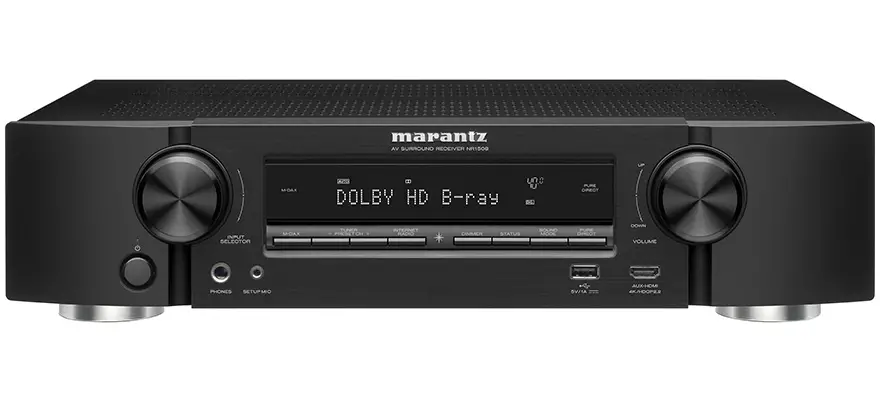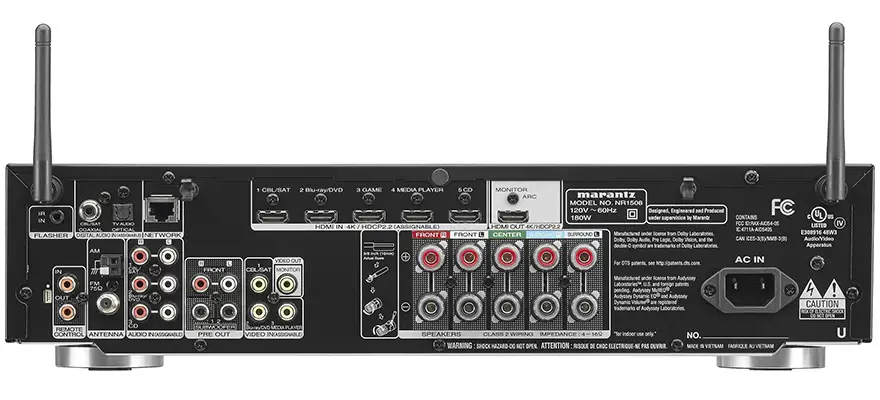New for 2017, the Marantz NR1508 slim style AV receiver offers a good variety of features most desired in a mid-priced model. The compact unit loses nothing but the tendency to take over the shelving area where it’s housed. At 4.1 inches tall, it neatly fits in the small areas that have been written off as wasted space until now. Instead of crowding the room with additional home theater electronics, it continues the legacy of the NR1501 by delivering an incredible range of sound from a small unit. Tiny houses are a big hit with space-challenged areas. What better way to respond to consumer needs and lifestyles than by offering other than chunky AVRs that reduce size rather than quality.

Marantz NR1508
Product Review
The NR1508 puts out an impressive 50 watts of power for each channel. The amps are amazing on the past slimline receivers and there’s every reason to be satisfied with its power now. What makes it so powerful? Start with six HDMI inputs that support 4K video passthrough at 60fp and Dolby Vision, HDR, and HDR10. A future firmware update will add Hybrid Log Gamma to the mix. Audio format is equally impressive since it decodes DTS-HD Master Audio Dolby TrueHD. Did I mention it’s one of the first receivers to include the HEOS multi-room music system from Denon?
The black aluminum front panel has a pair of control knobs. One provides access for source selection while the other adjusts volume. The resin edges are rounded and add to the sleek design. The blue LED display is highly visible. The unit’s width and depth compare to other AVRs; it’s the 4.1 inch height that makes it a popular compact unit that fits in tight spaces.
Below is the back panel layout. Click on image to enlarge for a clearer view.

Marantz NR1508 Back Panel
About the Product
It’s almost a given for the latest AVRs to display 4K ultra high definition video content. I expect a new unit of this caliber to last several years before new technology demands an upgrade. The Marantz NR1508 fulfills that expectation very well. I wasn’t quite sure if the HEOS wireless multiroom audio setup would create a satisfactory delivery of sound. Playback from Airplay and Bluetooth is just as impressive as the delivery from network streaming from services like iHeart Radio, Pandora, and Napster. Uncompressed audio is just as easy to access, as the unit supports hi-res 24bit/192khz and DSD 5.6MHz files. The AVR acts as a central hub by transmitting audio to HEOS speakers connected within the home.
Comparison of Marantz NR1508 and Denon AVR-S730H
The NR1508 and Denon’s S730H are nearly identical in width, while the 1508 has 2-4/16 inches more depth. The S703H 1-14/16 inches higher. The difference in weight is surprisingly just nine ounces. The Marantz unit has a better labor and parts warranty. In addition to DD, DD+, and TrueHD that both feature, the Denon S730H boasts Dolby Atmos and DTS:X.
A USB connection and ethernet port are included in each AVR. Both are Internet-ready and display a 20-20k Hz stereo frequency bandwidth. The main differences between the two comparable units is the number of channels (S730H has 7, NR1508 has 5) and the stereo RMS power (watts) of 75 as opposed to 50 in the slimline 1508. Audyssey MultEQ provides the auto speaker calibration for both AVRs. The competition is hot on its heels while Marantz continues to refresh the slimline range every other year. The HEOS multiroom music system is new to Marantz NR1508 this year, but that is basically the only significant change from the previous model, NR1506, and models before that.
Features
The NR1508 features a front-mounted USB port that’s handy for charging a phone or using a flash drive to play music. It supports surround standards like Dolby TrueHD and DTS-HD, but lacks playback for DTS:X and Atmos. One optical and one coaxial digital are accompanied by three analog inputs. Six HDMI inputs (one is in front) have HDMI 2.0a and HDCP 2.2 to playback 4K and HDR media, particularly Dolby Vision. The five-channel sound and single subwoofer provide a sufficient surround sound and resonance for smaller rooms. Escalating the volume failed to diminish audio clarity and quality. The 50 watts per channel is less than the typical 100 found on similar receivers, but was still impressive without straining.
The AVR:
- has Dolby True HD and DTS-HD decoding with conventional surround setup
- is compatible with the 4K ultra video formats on its six HDMI inputs
- can be controlled with the Marantz 2016 AVR app
- does not have Dolby Atmos or DTS:X coding
- can’t upconvert video to 4K video
Pros
- Compact unit with king-size delivery
- HEOS enhances audio experience
- Ethernet connection
Cons
- No Dolby Atmos or DTS:X support
Conclusion
The 5.1 sound released by the Marantz NR1508 is energetic and clear. Pairing them with higher end speakers will boost the delivery of this slim unit even more. The ultimate questions is the importance of having DTS:X and Dolby Atmos support. For many, it’s a valid reason to step up to the next level, such as the NR1608.
